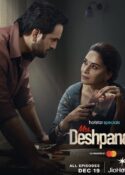 Long before she made the ferociously feted Laapata Ladies, Kiran Rao’s Dhobi Ghat, which released in 2010, was cinema at its purest shot in places where cameras are not allowed.
Long before she made the ferociously feted Laapata Ladies, Kiran Rao’s Dhobi Ghat, which released in 2010, was cinema at its purest shot in places where cameras are not allowed.
When we first enter the evocative macrocosmic world of Kiran Rao’s Mumbai, one of the characters has already snuffed out her life. We don’t know that. We only know what Arun, the whimsical elitist painter Arun (Aamir Khan), knows about this artless Muslim woman in the heartless city of Mumbai, which embraces everyone and favours none.
Dhobi Ghat is an exasperatingly cryptic yet convincing exploration of four unfinished dissatisfied lives in pursuit of a life beyond the present. Mumbai is a city in timeless transition. This film captures that intangible feeling of characters being trapped in a state of intermediary that you thought could never be put in a film. Dhobi Ghat makes emotions visible on camera. You catch the characters feeling their feelings when they think no one is looking.
Every protagonist wants to move to a new emotional and/or economic level of existence. Arun, a lately divorced painter, would like to melt that icy coldness that he has secreted around his heart. Shai (Monica Dogra), the anything-but-shy NRI, wants to discover the “real” Mumbai through her camera lens. She is the Indian tourist looking for ‘home’. Munna (Prateik Babbar), the most layered migrant in the plot, is the dhobi who wants to be Salman Khan. He wears tee shirts with pictures of rock bands like the Doors but is clueless about how to crack the rock in his own stock. Munna links all the characters together in a splendid snarl of complex emotions.
And Yasmin (Kirti Malhotra)… Poor innocent Yasmin. All she ever wanted from Mumbai was a sense of belonging in an alien city. Her cognac-eyes imploring her kid-brother in the video-recording to not mind the fact that she has lost her joie de vivre in a city that has no space for the sensitive. And yet Mumbai-God bless its all-accommodating cosmopolitanism-is not portrayed as a hostile city. The warmth and cross-cultural camaraderie comes across in the film through portrayals of individuals lost in the most crowded parts of Mumbai and yet somehow seeking and finding a sense of belonging within the feeling of acute isolation that hits you the minute your feet touch the magical mystical metropolitanism of Mumbai.
Tushar Kanti Ray’s camera stares languidly at Mumbai with curious eyes. We see the city in all its isolating yet all-encompassing splendour. The visuals would be called breathtaking in their evocativeness if they were not so true to life, almost documentary-like in their search for the authentic voice and visuals.
Barring Aamir Khan, all the faces are appropriately new. Monica Dogra, for example, who plays the camera-wielding class-challenged love-seeker from the US, is no actor. And that’s the best compliment we can pay her. Kriti Malhotra, on the other hand, who plays Yasmin, the city’s migrant casualty, is more of an ‘actor’ probably because she is only seen on the video camera with which she shot her ‘letters’ to her brother that Arun discovers when he moves into a new home, a new beginning, a new hope. He finally flees the haunting memories of Yasmin’s life without leaving a forwarding address. This, as we all know, often happens in Mumbai. The city is like that only.
 Every character in Dhobi Ghat is in constant search of a different, though not necessarily, better life. In her 95-minute narration, Kiran Rao packs in an eternity of expressed and unexpressed emotions. Indeed, she is a master of silences, with long stretches of the soundtrack being devoted to the sounds of quietude.
Every character in Dhobi Ghat is in constant search of a different, though not necessarily, better life. In her 95-minute narration, Kiran Rao packs in an eternity of expressed and unexpressed emotions. Indeed, she is a master of silences, with long stretches of the soundtrack being devoted to the sounds of quietude.
Dammit, even the outstanding background score by Gustavo Santaolalla is used with rigorous austerity. It is as though Rao won’t let her passion for understatement be overruled by her overwhelming love for the city of Mumbai. Each actor abandons all the skills and artifice of acting. Slanted suggestions of angst underline Aamir’s Arun. He is the painter who paints his pain. And not for financial gain. Aamir courts the canvas with a blend of vulnerability and warmth.
Prateik Babbar is among the most prized discoveries of recent times. His eyes and smile communicate a wealth of undefinable emotions. The way he breaks into a hint of a smile when Shai calls him handsome or in the film’s dying moments when, in a moment of heroic self-abnegation, he gives over his right to love Shai, Prateik proves himself a delightful little interpreter of delicate emotions. The narration is stylish and yet totally free of affectations.
The characters are people you’ve met on the streets of Mumbai, even if you don’t live in the city. And yet, they’re special. Not because they are so wonderfully framed and photographed in postures utterly bereft of camera consciousness. Not only because debutant director Kiran Rao knows her characters and how to interweave their lives into a story that offers unlimited scope for enigma intrigue and multitudinous interpretations. There’s something far more profound and, yes, pure at work here. This is cinema verite at its most honest. The lucidity of Kiran Rao’s vision emerges from layers of complex emotions buried in the heritage of Mumbai.
Dhobi Ghat is like that rich tapestried melody whose metre and rhythm you cannot ever forget even though the lines may be forgotten. A nostalgic elegiac enigmatic journey into the heart and soul of Bombay before the city became Mumbai it’s a splendid slice-of-life film with no camera consciousness visible in any of the characters.










